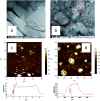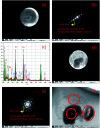Improvement of Cs detection performance and formation of CsCl and Cs nanoparticles by tuning graphene oxide quantum dot-based nanocomposite
- PMID: 35865579
- PMCID: PMC9257967
- DOI: 10.1039/d2ra02091b
Improvement of Cs detection performance and formation of CsCl and Cs nanoparticles by tuning graphene oxide quantum dot-based nanocomposite
Abstract
A new nanocomposite was developed using functionalized graphene oxide quantum dots (GOQDs) with cesium green molecules for the first time. Although the cesium green molecule works effectively only in the solid-state, without water, and in basic conditions, the functionalized GOQDs with cesium green made the nanocomposite work well as a cesium (Cs) detector in mixed solution (distilled water/THF). The nanocomposite can be employed as a Cs detector in both acidic and basic conditions. The present study revealed that the nanocomposite of GOQDs with cesium green showed an enhanced photoluminescence in basic conditions, while the intensity of the photoluminescence in acidic conditions is the superposition of the photoluminescence of the corresponding components. The photoluminescence of the nanocomposite was quenched (turned OFF) after Cs treatment in basic conditions. On the other hand, in the acidic conditions it was found that the photoluminescence intensity of this nanocomposite was enhanced (turned ON) by the Cs addition in two different Cs concentrations, 0.06 mmol L-1 and 0.12 mmol L-1. In addition, the movement of the nanocomposite (after Cs addition) under the electron beams through TEM measurement was observed. The formation of CsCl and Cs nanoparticles was identified. Specifically, the Cs cluster occurrence is discussed by taking into account the mobility effect of the adatoms on the composite layer under electron beam irradiation.
This journal is © The Royal Society of Chemistry.
Conflict of interest statement
There are no conflicts to declare.
Figures









Similar articles
-
Graphene oxide quantum dot-chitosan nanotheranostic platform as a pH-responsive carrier for improving curcumin uptake internalization: In vitro & in silico study.Biomater Adv. 2022 Aug;139:213017. doi: 10.1016/j.bioadv.2022.213017. Epub 2022 Jul 6. Biomater Adv. 2022. PMID: 35882115
-
Electrochemical Method To Prepare Graphene Quantum Dots and Graphene Oxide Quantum Dots.ACS Omega. 2017 Nov 28;2(11):8343-8353. doi: 10.1021/acsomega.7b01539. eCollection 2017 Nov 30. ACS Omega. 2017. PMID: 31457373 Free PMC article.
-
Exploration of the Cs Trapping Phenomenon by Combining Graphene Oxide with α-K6P2W18O62 as Nanocomposite.Materials (Basel). 2021 Sep 26;14(19):5577. doi: 10.3390/ma14195577. Materials (Basel). 2021. PMID: 34639973 Free PMC article.
-
Facile synthetic method for pristine graphene quantum dots and graphene oxide quantum dots: origin of blue and green luminescence.Adv Mater. 2013 Jul 19;25(27):3657-62. doi: 10.1002/adma.201300233. Epub 2013 May 27. Adv Mater. 2013. PMID: 23712762
-
Graphene Oxide Quantum Dot-Based Functional Nanomaterials for Effective Antimicrobial Applications.Chem Rec. 2020 Dec;20(12):1505-1515. doi: 10.1002/tcr.202000090. Epub 2020 Sep 25. Chem Rec. 2020. PMID: 32975907 Review.
Cited by
-
Recycling Motorcycle Exhaust Soot into Fluorescent Graphene Oxide Quantum Dots for Sensing Ferrocyanide Ions and Bioimaging Cells: A Method for Waste Utilization.ACS Omega. 2025 Mar 31;10(14):14229-14240. doi: 10.1021/acsomega.5c00229. eCollection 2025 Apr 15. ACS Omega. 2025. PMID: 40256545 Free PMC article.
References
-
- Basuki T. Miyashita S. Tsujimoto M. Nakashima S. “Deposition density of 134Cs and 137Cs and particle size distribution of soil and sediment profile in Hibara Lake area, Fukushima: an investigation of 134Cs and 137Cs indirect deposition into lake from surrounding area”. J. Radioanal. Nucl. Chem. 2018;316(3):1039–1046. doi: 10.1007/s10967-018-5809-1. - DOI
-
- TSUJIMOTO M. MIYASHITA S. NGUYEN H. T. NAKASHIMA S. “Monthly Change in Radioactivity Concentration of 137Cs, 134Cs, and 40K of Paddy Soil and Rice Plants in Fukushima Prefecture”. Radiat. Saf. Manag. 2020;19:10–22. doi: 10.12950/rsm.181219. - DOI
LinkOut - more resources
Full Text Sources
Miscellaneous

